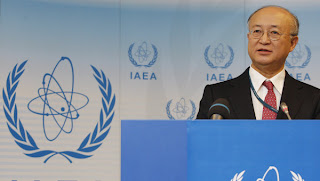A nuclear power plant is a thermal power station in which the heat source is a nuclear reactor. As in a conventional thermal power station the heat is used to generate steam which drives a steam turbine connected to a generator which produces electricity. As of February 2, 2012, there were 439 nuclear power plants in operation.[1]
Nuclear power plants are usually considered to be base load stations, since fuel is a small part of the cost of production.[2]
History
- For more history, see nuclear reactor, nuclear power and nuclear fission.
Electricity was generated by a nuclear reactor for the first time ever on December 20, 1951 at the EBR-I experimental station near Arco, Idaho in the United States. On June 27, 1954, the world's first nuclear power plant to generate electricity for a power grid started operations at Obninsk, USSR.[3] The world's first commercial scale power station, Calder Hall in England opened on October 17, 1956.[4]
Systems
This section has recently been translated from the German Wikipedia.
The conversion to electrical energy takes place indirectly, as in
conventional thermal power plants. The heat is produced by fission in a
nuclear reactor (a light water reactor).
Directly or indirectly, water vapor (steam) is produced. The
pressurized steam is then usually fed to a multi-stage steam turbine.
Steam turbines in Western nuclear power plants are among the largest
steam turbines ever. After the steam turbine has expanded and partially
condensed the steam, the remaining vapor is condensed in a condenser.
The condenser is a heat exchanger which is connected to secondary side
such as a river or a cooling tower. The water is then pumped back into the nuclear reactor and the cycle begins again. The water-steam cycle corresponds to the Rankine cycle.
Nuclear reactors
Main article: Nuclear reactor
A nuclear reactor is a device to initiate and control a sustained nuclear chain reaction. The most common use of nuclear reactors is for the generation of electric energy and for the propulsion of ships.
The nuclear reactor is the heart of the plant. In its central part,
the reactor core's heat is generated by controlled nuclear fission. With
this heat, a coolant is heated as it is pumped through the reactor and
thereby removes the energy from the reactor. Heat from nuclear fission
is used to raise steam, which runs through turbines, which in turn powers either ship's propellers or electrical generators.
Since nuclear fission creates radioactivity, the reactor core is
surrounded by a protective iron shield. This containment absorbs
radiation and prevents radioactive material
from being released into the environment. In addition, many reactors
are equipped with a dome of concrete to protect the reactor against
external impacts.
In nuclear power plants, different types of reactors, nuclear fuels, and cooling circuits and moderators are sometimes used.
Steam turbine
Main article: Steam turbine
The object of the steam turbine is to convert the heat contained in
steam into mechanical energy. The engine house with the steam turbine is
usually structurally separated from the main reactor building. It is
aligned to prevent debris from the destruction of a turbine in operation
from flying towards the reactor.
In the case of a pressurized water reactor, the steam turbine is
separated from the nuclear system. To detect a leak in the steam
generator and thus the passage of radioactive water at an early stage is
the outlet steam of the steam generator mounted an activity meter. In
contrast, boiling water reactors and the steam turbine with radioactive
water applied and therefore part of the control area of the nuclear
power plant.
Generator
Main article: Electric generator
The generator converts kinetic energy supplied by the turbine into
electrical energy. Low-pole AC synchronous generators of high rated
power are used.
Cooling system
A cooling system removes heat from the reactor core and transports it
to another area of the plant, where the thermal energy can be harnessed
to produce electricity or to do other useful work. Typically the hot
coolant is used as a heat source for a boiler, and the pressurized steam from that boiler powers one or more steam turbine driven electrical generators.[5]
Safety valves
In the event of an emergency, two independent safety valves can be
used to prevent pipes from bursting or the reactor from exploding. The
valves are designed so that they can derive all of the supplied flow
rates with little increase in pressure. In the case of the BWR, the
steam is directed into the condensate chamber and condenses there. The
chambers on a heat exchanger are connected to the intermediate cooling circuit.
Feedwater pump
The water level in the steam generator and nuclear reactor is
controlled using the feedwater system. The feedwater pump has the task
of taking the water from the condensate system, increasing the pressure
and forcing it into either the Steam Generators (Pressurized Water
Reactor) or directly into the reactor vessel (Boiling Water Reactor).
Emergency power supply
The emergency power supplies of a nuclear power plant are built up by
several layers of redundancy, such as diesel generators, gas turbine
generators and battery buffers. The battery backup provides
uninterrupted coupling of the diesel/gas turbine units to the power
supply network. If necessary, the emergency power supply allows the safe
shut down of the nuclear reactor. Less important auxiliary systems such
as, for example, heat tracing of pipelines are not supplied by these
back ups. The majority of the required power is used to supply the feed
pumps in order to cool the reactor and remove the decay heat after shut
down.
Sumber:




.jpg)





